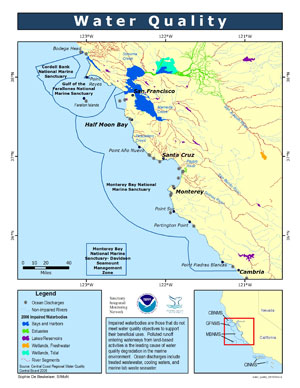
The three northern California sanctuaries provide habitat for a wealth of biological diversity. The organisms that reside in or visit the region depend upon clean water, as do all our commercial and recreational uses.
Greater Farallones and Monterey Bay National Marine Sanctuaries border the California coastline and receive runoff from watershed regions that support a variety of land uses.
Greater Farallones sanctuary is influenced by the San Francisco Bay metropolitan area. Further to the south, Monterey Bay sanctuary is somewhat less vulnerable to industrial discharges and large point sources of pollution. However, by virtue of being adjacent to such a large extent of coastline, it is still susceptible to the effects of non-point, urban, rural and agricultural pollution sources.
Cordell Bank National Marine Sanctuary is far enough offshore to be relatively free of any direct impacts associated with terrestrial inputs. As such, it is thought that water quality within that sanctuary is relatively good. However, seasonal variations, due to precipitation and current patterns, have been observed. For example, researchers have observed impacts at the bank from the severe flooding of coastal counties: debris such as large logs, dock pilings, floats, bottles, plastic sheets and much more, all likely originating from San Francisco Bay, demonstrated that extended El Niño conditions with heavy rains can affect water quality even far offshore.
Monitoring
To improve the water quality conditions in the sanctuaries, it is important to understand fully where the pollution comes from, where it is going, what its impacts are and if its concentration is increasing or decreasing over time.
A number of water quality monitoring programs are underway in Cordell Bank sanctuary:
- Cordell Bank Ocean Monitoring Program
- Marine Biotoxin Monitoring and Control Program
- Cordell Bank Oceanographic Buoy
Ongoing monitoring programs also operate within Monterey Bay sanctuary and its watersheds. These include, among others:
- The Central Coast Ambient Monitoring Program (CCAMP)
- The Central Coast Long-term Environmental Assessment Network (CCLEAN)
- The Sanctuary Citizen Watershed Monitoring Network
- The Coastal Watershed Council (CWC)
- Central Coast Watershed Studies (CCoWS) group
- The US Geological Survey (USGS)
- The Elkhorn Slough National Estuarine Research Reserve (ESNERR)
- Santa Cruz and Monterey County Departments of Environmental Health